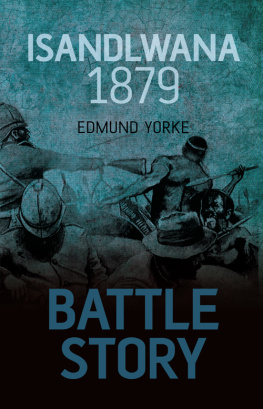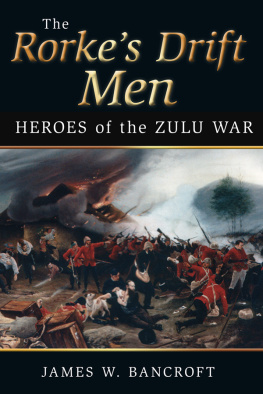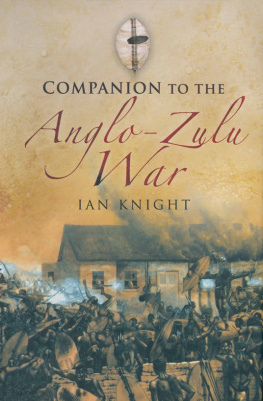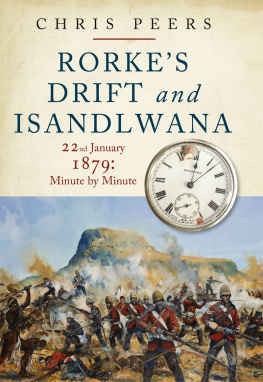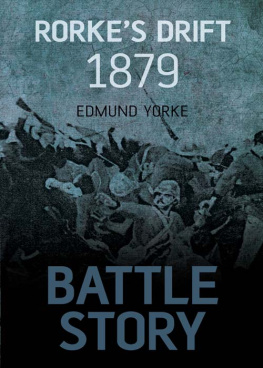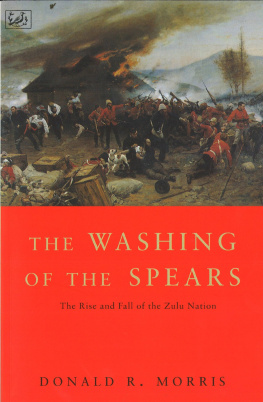
For Louise, Madeleine and Emily
CONTENTS
The British Forces
The Zulu Army in 1879
The Zulu Commanders, Tactics and Logistics
The British Commanders, Tactics and Logistics
Policy Reversal: an Imperial Betrayal?
Slumbering on a volcano: Freres Security Crisis
Government Vacillation
The Hicks Beach U-Turn
Ultimatum: Frere Exceeds his Instructions
The British Invasion
Skirmish at Sihayos kraal (12 January 1879)
The Doomed Isandlwana Campsite: 2022 January 1879
Zulu Feint: The Dartnell Diversion
First Contacts and Opening Salvoes
The Main Battle
The Climax and Final Moments of the Battle
The Flight from Isandlwana
Chelmsfords Return to Isandlwana
Battle Analysis: The Lessons of the Disaster
Postscript
I wish to express my gratitude to many individuals who contributed to this work. The librarians, curators and archivists of the Universities of Oxford and Cambridge, the National Army Museum, the London Library, the Public Record Office at Kew, and the South Wales Borderers Museum in Brecon have been particularly helpful. Andrew Orgill, Senior Librarian of RMA Sandhurst Library, and his assistants, Ken Franklin and John Pearce, have provided their usual sterling and exceptional support. The Commissioning Editor Jo de Vries and her team at the History Press have also provided invaluable advice and encouragement.
The works and advice of several authors and experts in the field, notably Professor John Laband, Mr Ian Knight, Mr F.W. Jackson, John Young, Ron Lock, Peter Quantrill, Lieutenant Colonel Mike Snook and the late, much lamented David Rattray, Donald Morris and Frank Emery, have, over the years, jointly provided great inspiration for this book. My most recent 2004 visit to the Isandlwana battlefield and attendance at the splendid 125th commemorative dinner held in Isandlwana Lodge, so charmingly hosted by Pat Stubbs, enabled me to renew many old acquaintances and to make many new ones. Major Andrew Banks and John Young both provided excellent pictorial support from their extensive private collections to supplement my own field photographs. F.W. Jackson has been a source of great advice and encouragement, and the several meetings and dinners we have recently enjoyed together remain treasured memories. Mrs Susan Coleridge, currently working on a major reappraisal of the life of Colonel Anthony Durnford, has been a most useful source of information, especially on Durnfords still controversial role at Isandlwana. Above all, I must thank my great friend Colonel Ian Bennett (RLC retired). Our regular triennial lunches at Sandhurst and joint excursions and research trips have been a wonderful source of intellectual advice and encouragement. Several of my colleagues at RMA Sandhurst have also been of great help, notably my current Head of Department, Dr Duncan Anderson MA, Dr Gregory Fremont-Barnes, Professor Christopher Duffy, Dr Matthew Bennett and Mr Sean McKnight, MA, Director of Studies. Mention must also be made of the scores of officer-cadets and commissioned officers who, over the past twenty-two years, have shared my great enthusiasm for this famous battle.
Above all I must express my deep love and appreciation for the long-suffering support of my dear wife Louise and daughters, Madeleine and Emily, the former for the long tedious hours of rapid word processing of reams of documents and indecipherable notes, and, the latter, for the many hours of neglect by their elusive Daddy. I also wish to thank my dear family, especially my parents and elder sister, Liz, (the latter braved the many 2004 Isandlwana battlefield treks and mad obsessions of her brother), who have been an enormous source of encouragement and enthusiasm.
1Sketch map of South Africa, 1879.
2The Earl of Carnarvon, the primary catalyst behind the South African Confederation. (JY)
3Sir Henry Bartle Edward Frere (181584), Governor of the Cape and High Commissioner for South Africa since 1877, entrusted with the arduous task of completing Lord Carnarvons ailing confederation scheme. (JY)
4Sir Michael Hicks Beach, Secretary of State for the Colonies. (JY)
5Officers, NCOs and men of the (1st Battalion, probably) 24th Regiment, pictured in Zululand in 1879. Note the officers sphinx cap badge, young drummer boy/musician and the prevalence of beards worn by many of the lower ranks. (RMAS)
6Martini-Henry rifles and ammunition box from the Zulu War period. (EY)
7A 24th Regiment water bottle found on the Isandlwana battlefield. (RRWM)
8Close-up of the Martini-Henry firing mechanism. (EY)
9Chief Cetshwayo Ka Mpande (183284) in traditional dress. (JY)
10The formidable lunger socket bayonet. (EY)
11A typical Zulu warrior. Zulu boys would be taught basic economic and military skills at military kraals, known as amakhanda. (AB)
12A classic, accurate engraving of a Zulu charge. Note the deployment of muskets alongside traditional spears and assegais. (EY)
13Zulu warrior group (AB)
14Colonel R.T. Glyn, Commander of No. 3 Column and heavily criticised in Chelmsfords recently discovered memo of February 1879. (RRWM)
15The swotting of a Zulu wasp by the British lion. This 1879 Punch cartoon graphically shows that the Zulu threat was only one of several problems besetting the hard-pressed Disraeli government.
16The perils of campaigning in Zululand, Punch, August 1879.
17A rare contemporary view of Rorkes Drift crossing point on the Mzinyathi (Buffalo) River. (JY)
18Commissariat stores on the Lower Tulega. (JY)
19Lord Chelmsford, pictured after the Zulu War. (JY)
20A watercolour copy of Colonel Crealocks evocative 20/21 January paintings of the Isandlwana Camp. A deceptively tranquil scene with a lone sentry and cattle lazily grazing. A few hours later it was to be the scene of a terrible massacre. (EY)
21Lieutenant Charles DAguilar Pope. (RRWM)
22Map of the Isandlwana battle around 1pm.
23A rough sketch of the Isandlwana campsite. (C.L. Norris-Newman, In Zululand with the British (Allen & Co., 1880))
24Captain Reginald Younghusband, 24th Regiment. (JY)
25An extremely rare photograph of Captain George Wardells 1/24th H Company, annihilated at Isandlwana. (RRWM)
26Lieutenant Mainwarings sketch and watercolour of the Isandlwana Campaign. (RRWM)
27Brevet Colonel Anthony William Durnford (183079) whose aggressive tactics at Isandlwana may have fatally compromised Pulleine. (JY)
28A classic recent view of the Isandlwana battlefield from the campsite, looking towards the Nqutu Plateau. The distinctive conical kopje can be clearly seen, around which the Zulu impis attacked. (EY)
29Brevet Lieutenant Colonel Henry Burmester Pulleine (183979), the ill-fated commander of the Isandlwana garrison. (JY)
30Lieutenant Charles Walter Cavaye, 24th Regiment. (JY)
31Lieutenant Edward Lucky Essex, one of only five imperial officers who escaped from Isandlwana. (JY)
32View from the 24th Regiment firing line from where, behind the boulders, the Zulu advance was temporarily stemmed. (EY)
33An informal group photograph of the 24th Foot officers before the outbreak of war (1878). (JY)
34Sketch of Isandlwana Camp (1pm). (RA)
35a A 7 pounder gun used by Chelmsfords No. 3 Centre Column. (EY)
35bA 7 pounder shell recovered from the Isandlwana battlefield. (RRWM)
36A good view of Isandlwana peak, looking across the saddle where the wagon park was situated. (EY)
37The ledge below Isandlwana Crag, where Younghusband and sixty-odd men made their last stand. (EY)
Next page
